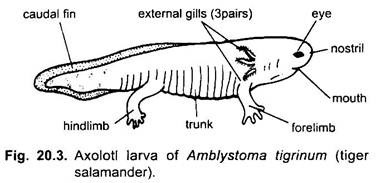In this article we will discuss about the neoteny and paedogenesis of amphibia with help of a suitable diagram.
In the genus Amblystoma (urodele) the animal sometimes becomes sexually mature in the larval condition and does not metamorphose (Siredon, the axolotl). This phenomenon of the retention of larval characters in the sexually mature state has been called neoteny or paedogenesis. It is not confined to Amblystoma but is found occasionally in the genus Triton.
It is a physiological adaptation. It also happens in Necturus and Amphiuma (obligate neoteny) and in these metamorphosis cannot be induced by thyroxine T4. While in axolotl, Amblystoma, some or all of the individuals of a given population metamorphose. In these facultative neotenes thyroxine T4 generally induces metamorphosis. Neoteny is due to a low level of thyrotropin releasing hormone (TRH) probably due to a combination of genetic predisposition with environmental factors.
Lack of iodine has been shown to produce epigenetic suppression of metamorphosis as in an English population of Triturus. In neoteny the terrestrial phase is eliminated, the aquatic larva becomes sexually mature. The larval stage is often considered as a survival of the ancestral fish type.
Paedomorphosis is the retention of those characters which occurred in younger stages of the ancestors of a sexually mature descendant. It is considered that paedogenesis (reproduction in a pre-adult form) has been a powerful influence in the evolution of at least some animal types (Garstang). A classical case of paedogenesis is provided by the Mexican Axolotl, which frequently breeds in the gilled or larval state.
The experimental administration of thyroxin, especially when the animal is very young, causes it to lose its gills, develop lungs, and emerge from the water in an adult form very like the black and orange tiger salamander (Amblystoma tigrinum) of North America.
Metamorphosis can be induced also by reducing the water level in which the axolotl lives and, thus, making gill respiration difficult, while at the same time facilitating pulmonary respiration. It is to the branchiate stage that the name Axolotl properly applies.
